|
volante:
australia

Investigating Tara Moss
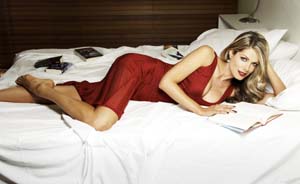
During an exclusive guided tour of Sydney, her beloved adopted hometown, international
best selling author Tara Moss does what a good writer should—create an intriguing
atmosphere, revealing some interesting aspects of her character and leaving
other things up to the imagination by Elyse Glickman
Expanded from
issue 24 of Lucire
IS TARA
MOSS a real-life superhero? She probably
wouldn’t think so, but anybody who gets the chance to see her in
person or even have a chat with her would probably disagree. Moss
was born in British Columbia, relocated to Australia and has been
raising a very demure and chic form of hell around the world ever
since. While other beauties coast on beauty until they can’t anymore
(or else land a lucrative merchandising deal for Target, K-mart
or the Home Shopping Network), Moss doesn’t sell a lifestyle. Rather,
she has become one unto herself.
Though I interviewed her by phone two years ago
for The Book LA, a prestigious Los Angeles ‘coffee table’
arts magazine on the US release of
Fetish, and international debut of her third novel, Covet,
I was still somehow taken by surprise when we met for this interview,
face to face, and on her turf. Going in, I knew she had a hugely
successful run as a model between the time the mystery writing bug
first hit her and her subsequent literary triumph on an international
scale. I also knew that while the rest of the world was just that
into her and her alter ego Makedde ‘Mak’ Vanderwall, the US
was just meeting the fledgling female hero (not ‘heroine’, for reasons
you will discover soon). The woman behind the unstoppable Mac was
also, very literally, riding high, jumping out of planes, researching
real murders, racing cars and motorbikes, taping a true crime show
(Tara Moss Investigates) for National Geographic Channel
and yet still finding some time to land the perfect Vivienne Westwood
earrings or Italian leather boots.
On a humid late summer day in Sydney, she calls
me by mobile during my ‘indulgence’ breakfast at Bills (Sydney’s
current "it" place for decadent ricotta hotcakes with
honeycomb butter) to set a time for our meeting. She has a slightly
gravelly, reassuring voice that somehow reminds you of your best
friend. Two hours later, at the appointed time, opposite the buzzing
boutiques and Paddington Market along Oxford Street, she emerged
from a throng of passing shoppers, looking almost too good to be
real. Six feet plus, non-ending legs, frizz-free hair and dressed
very girly in a Wheels & Doll Baby mini-dress accessorized with
Vivienne Westwood earrings, oversized Jackie O-style sunnies and
Sonya Rykiel satchel. Then as she gets closer, some revealing details
appear, the dress and earrings are skulls, she was a wicked smile,
and she’ll suddenly stop in her tracks at the appearance of one
very cherry motorbike.
‘Wow,’ she says, almost out of breath. ‘There’s
my dream bike: a Triumph Rocket 3, the most powerful bike I have
ever seen. I have a Triumph Scrambler, which has 900 cc of power.
It’s the same one as what Steve McQueen rode famously in The
Great Escape.’
Noticing I am not an authority on bikes, she
patiently and literally brings me up to speed. ‘It is a very powerful
bike, especially considering most people ride 650 or 700 cc bikes.
Now that bike over there is completely off the hook in terms
of power, and more powerful than most cars. This bike could probably
tow things. One day, I would like to be able to handle something
like this. But for now, I wouldn’t be able to lift it if it fell
over, so I will probably have to work out and build up my upper
body strength before I dare do the Rocket.’
Somehow, I think in the end she won’t have any
trouble making that dream a reality for herself. After all, she’s
barely in her 30s and has maintained three dream careers—model,
novelist and television personality. However, she doesn’t see the
modelling niche of her life as dreamy. Instead, she found it rather
than uninteresting, except for the fact that it enabled her to travel
to some choice destinations and provide her with great opportunities
to network and ask lots of questions to experts in the areas she
was interested in, ultimately providing her with the confidence
eight years to leave easy money behind in favour of more overwhelming
and ultimately fulfilling challenges. And there were times when,
contrary to what one would expect, being a recognizable model didn’t
make getting a foot in the door for what she really wanted
to do easier.
‘I had to work twice as hard to gain the credibility
I needed required to get into places like the American FBI
academy, and some of the other educational institutions where I
needed to do research to make the characters and stories believable
and visceral,’ she responds in surprise when I asked the inevitable
question on if her model status and looks gave her any sort of carte
blanche. ‘I embraced that challenge, however. I also find that,
depending on what country I do my research in, many people I meet
actually don’t know about my model background, and that actually
helps me a lot. Besides, with a model background, when you do research
for your novel at a prison, you do not want the locals to take interest
in you and look up your photos online. It’s not the best way to
go about things.’
We pause to look at business card cases and compacts,
and for a while, Tara shifts back into femme mode.
‘I like that it’s a business case, but there’s
a reflective surface so you can touch up your lipstick,’ she notes.
‘Is it made in Australia?’ I ask the vendor
‘No,’ the vendor says, ‘It’s made in China.’
‘Isn’t that typically Australian?’ Tara muses
as her eyes wander to another part of the table. ‘Now this is
cool, classic German cigarette cases …’
‘Which in our politically correct times are really
business card cases,’ I quip, at last feeling like her equal in
wit and spontaneity.’
‘You’re absolutely correct,’ she says, validating
me, before a mischievous smile extends across her face when her
eye hones in on the next vendor table.
‘And that belt! Paris Hilton could probably wear
this as a skirt.’ Tara breaks up into laughter, and I follow. ‘No,
I really think she would,’ she says inspecting the belt’s width
and over-the-top embellishments.
‘Do you actually buy stuff here?’
‘I do … and I love the smell of leather, she
says inspecting another couture grade bag. You can never have too
many handbags, or too many belts,’ she adds.
Amid the baked goods and girly wares, we stumble
upon a table displaying artistically preserved butterflies and insects.
While I am (predictably) drawn to the delicate butterflies, Tara
makes a beeline for an impressive tarantula preserved in Lucite.
‘This is up my alley,’ she says in an upscale
drawl that evenly splices together her Canadian dialect with distinctively
Australian inflections. ‘These are fabulous. The tarantula
is a little bit gruesome, but I like it. There is great beauty in
death. I have a bat at home in a little case, so I must get this
tarantula as well. Did you also note that the male insects and butterflies
are the ones with all the fabulous accessories?’
The preserved creatures also prompt her to muse
on her future ambition to write a ‘dystopian society’ novel or series
along the lines of other classics like Children of Men, The
Handmaid’s Tale and 1984 among them. For now,
however, she pointedly says she is focused bringing her baby, Makedde
Vanderwall, into greater heights of maturity.
‘While you could call each novel in the series
a sequel, each novel is actually self-contained and works on its
own as well, as you can read them chronologically or separately
and they will still make sense,’ Tara points out almost academically.
‘While each novel has a separate group of characters, the one who
remains constant is Mak, because I really like writing her. She’s
a great character, and my alter ego. She does things I would never
do and vice versa. She’s a better motorcyclist than I am, she doesn’t
age as quickly as I do, and she’s got a really, really good roundhouse
kick! I am working on mine and its getting pretty good, but hers
is much better.’
The day is as hot as it gets in Sydney (a situation
not improved by hordes of treasure hunters at Paddington Market).
Though Tara complains of the heat—albeit in a very no-sweat kind
of way—you would never see her wilt. As we weave pass vintage clothing,
and pause to gawk at jewellery and more leather accessories, she
weaves in that when she quit modelling, she was so motivated to
remedy her initial lack of driving skills by getting her driver’s
licence, motorcycle licence and race car driver’s licence within
space of six months. Now, when not hammering out the details of
her fifth book, promoting the fourth novel and signing with a prestigious
Los Angeles literary agency, she in the process of getting a helicopter
pilot’s licence and has recently persuaded three of her Sydney-based
girlfriends to become card-carrying bike enthusiasts and form a
sort of glam girl gang, hitting Sydney’s daytime hotspots to raise
hell.
‘We’re kind of like a modern version of the girl
gang from the Russ Meyer cult classic Faster Pussycat, Kill Kill
Kill,’ she says pertly. ‘In fact, if you look at that movie,
it was a very empowering movie, full of self-assured women who did
not exist to be rescued. I have even maintained a friendship with
the actress from that film who was noted as the first woman to kill
a male character with her bare hands on screen.’
continued
Read this article
in issue 24 of Lucire in print.
Add
to Del.icio.us | Digg
it | Add
to Facebook
|
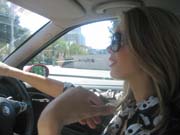
Tara behind the wheel
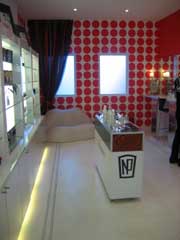
Perdis on Oxford
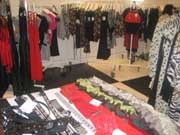
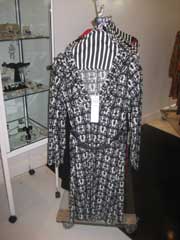
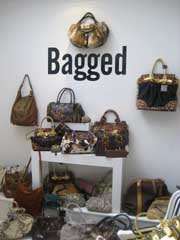

Charlie Brown
Now, when not hammering out the details of
her fifth book, promoting the fourth novel and signing with a prestigious
Los Angeles literary agency, she in the process of getting a helicopter
pilot’s licence and has recently persuaded three of her Sydney-based
girlfriends to become card-carrying bike enthusiasts and form a
sort of glam girl gang, hitting Sydney’s daytime hotspots to raise
hell
|

